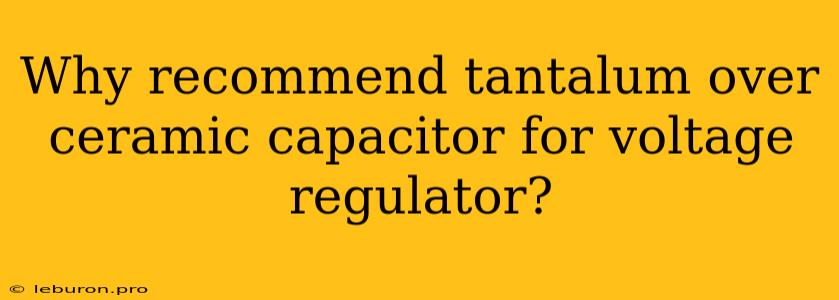Why Tantalum Capacitors Often Outshine Ceramic Capacitors in Voltage Regulators
In the intricate world of electronics, choosing the right capacitor for a voltage regulator is critical. While ceramic capacitors are a popular choice due to their affordability and availability, tantalum capacitors often emerge as the superior option for specific applications. This article will delve into the reasons why tantalum capacitors are frequently favored over ceramic capacitors in voltage regulators, highlighting their unique advantages and suitability for critical circuit designs.
Understanding the Role of Capacitors in Voltage Regulators
Voltage regulators, essential components in electronic circuits, maintain a stable output voltage despite fluctuations in the input supply. Capacitors play a crucial role in this process by acting as energy storage devices. They smooth out voltage ripples and transients, ensuring a clean and consistent output. The type of capacitor chosen significantly impacts the performance and reliability of the voltage regulator.
Key Advantages of Tantalum Capacitors for Voltage Regulators:
-
Higher Capacitance: Tantalum capacitors boast significantly higher capacitance values compared to ceramic capacitors of similar size. This translates into a larger energy storage capacity, essential for smoothing out voltage fluctuations and maintaining a stable output voltage.
-
Lower Equivalent Series Resistance (ESR): Tantalum capacitors exhibit a lower ESR, which is the internal resistance of the capacitor. Lower ESR ensures efficient energy transfer with minimal energy loss, improving the voltage regulator's efficiency and reducing heat dissipation.
-
Excellent Frequency Response: Tantalum capacitors excel in handling high frequencies, making them ideal for circuits with fast transients or switching frequencies. Their superior frequency response ensures stable performance even under demanding conditions.
-
Superior Stability: Tantalum capacitors maintain their capacitance value over a wide range of temperatures and voltages, ensuring consistent performance. This stability is crucial for maintaining voltage regulation accuracy over time.
-
Longer Life Expectancy: Tantalum capacitors are known for their extended life expectancy, often surpassing ceramic capacitors in terms of reliability and longevity. They are particularly well-suited for applications with rigorous usage patterns or long operating cycles.
Limitations of Ceramic Capacitors in Voltage Regulator Applications:
-
Lower Capacitance Values: Ceramic capacitors typically offer lower capacitance values compared to tantalum capacitors of the same size, making them less effective in smoothing out voltage fluctuations.
-
Higher ESR: Ceramic capacitors have a higher ESR, leading to greater energy loss and potential instability in voltage regulation.
-
Limited Temperature Stability: Ceramic capacitors are known for their sensitivity to temperature variations, resulting in capacitance shifts and potential instability in voltage regulation.
-
Susceptibility to Polarization: Certain types of ceramic capacitors, such as polarized ceramic capacitors, can be damaged by applying a reverse voltage. This limitation can complicate circuit design and maintenance.
-
Potential for Instability in High-Frequency Applications: Ceramic capacitors can exhibit instability and reduced performance at higher frequencies, making them unsuitable for applications demanding fast switching or high-frequency operation.
Choosing the Right Capacitor for Your Voltage Regulator:
While tantalum capacitors offer many advantages for voltage regulators, it's crucial to consider the specific requirements of your circuit and select the capacitor type that best meets your needs.
Factors to consider:
- Required Capacitance: Determine the capacitance value required for your specific application.
- Operating Frequency: Choose a capacitor suitable for the operating frequency of your circuit.
- Voltage Rating: Ensure the capacitor's voltage rating is sufficient for your application.
- Environmental Considerations: Consider the operating temperature range and other environmental factors.
Tantalum capacitors are often the preferred choice for:
- High-performance voltage regulators demanding high capacitance and low ESR.
- Applications operating at high frequencies or experiencing rapid voltage changes.
- Systems requiring long-term reliability and extended life expectancy.
Ceramic capacitors can be suitable for:
- Low-power voltage regulators where capacitance requirements are minimal.
- Applications operating at lower frequencies.
- Circuits with less demanding performance requirements.
Conclusion:
When choosing a capacitor for your voltage regulator, the choice between tantalum and ceramic depends on the specific requirements of your application. Tantalum capacitors offer advantages in terms of capacitance, ESR, frequency response, stability, and life expectancy, making them the preferred choice for high-performance voltage regulators. While ceramic capacitors may be more economical, their limitations in terms of capacitance, ESR, and stability can compromise the performance and reliability of your circuit. By carefully evaluating your design needs and considering the advantages and disadvantages of each type of capacitor, you can ensure the optimal performance and longevity of your voltage regulator.
